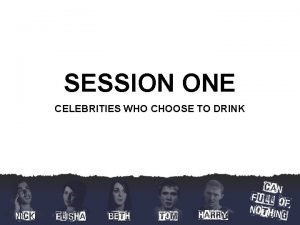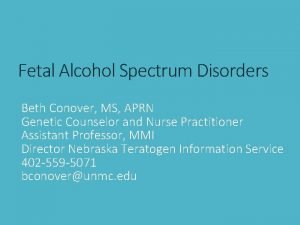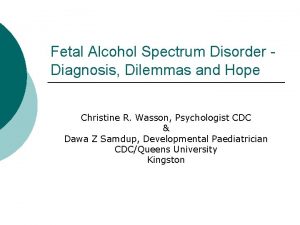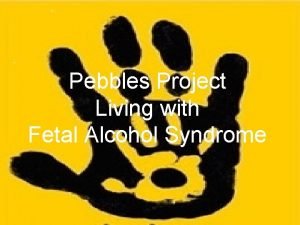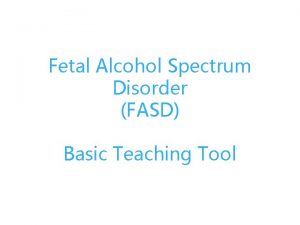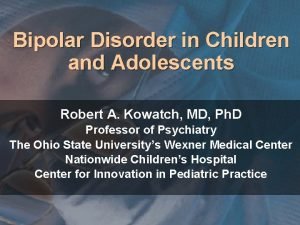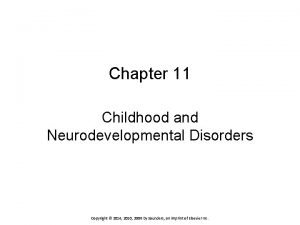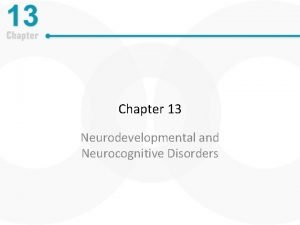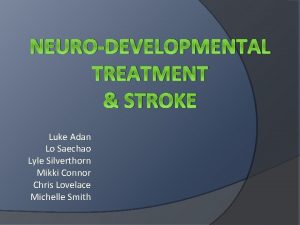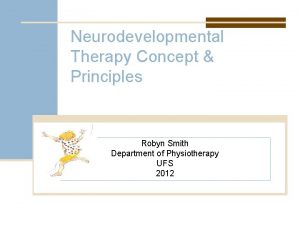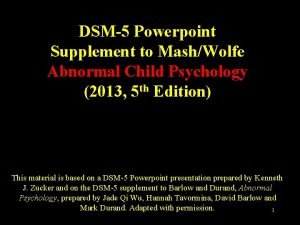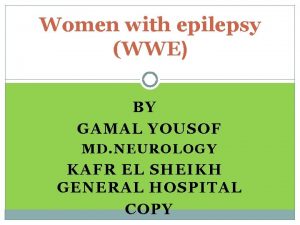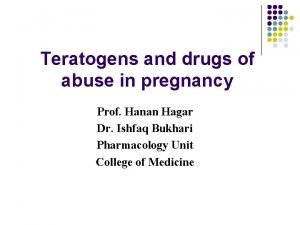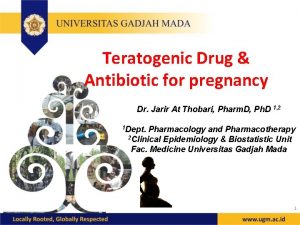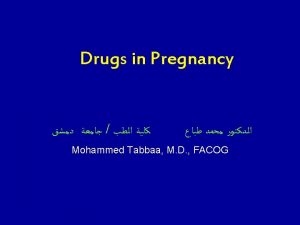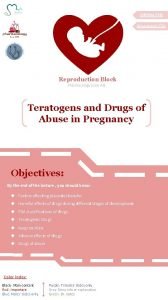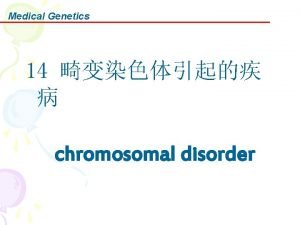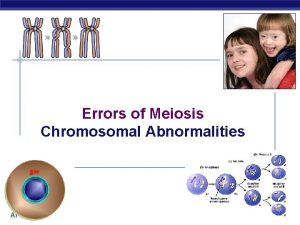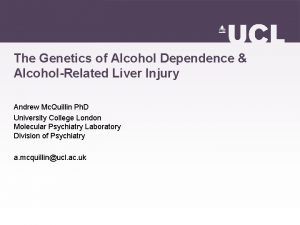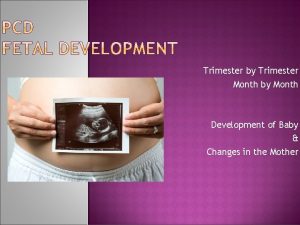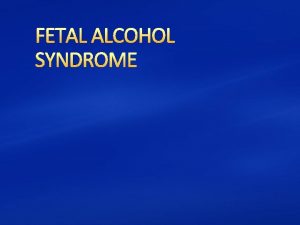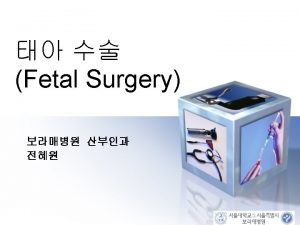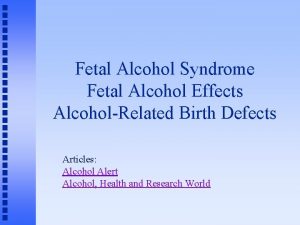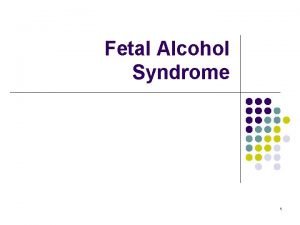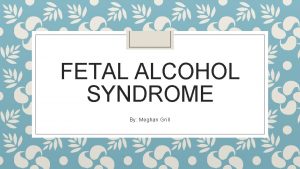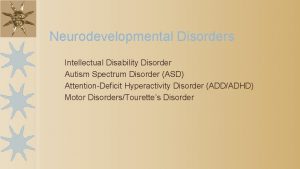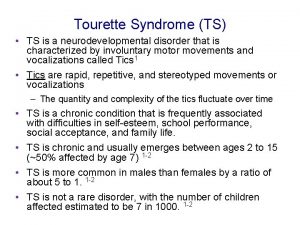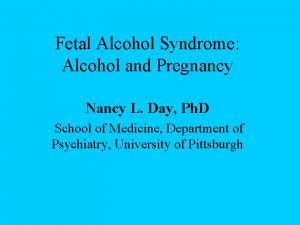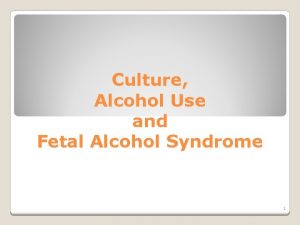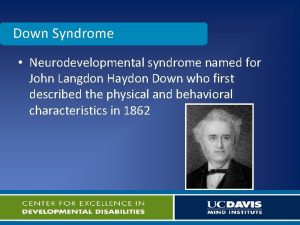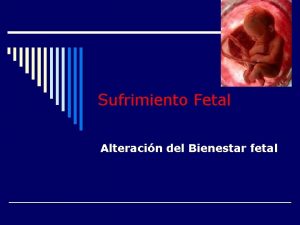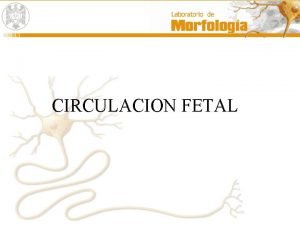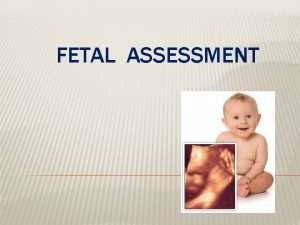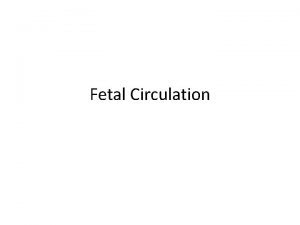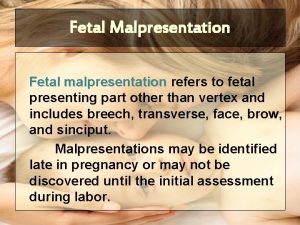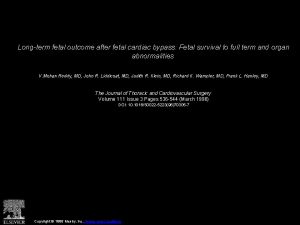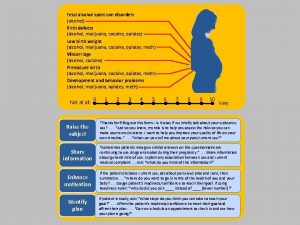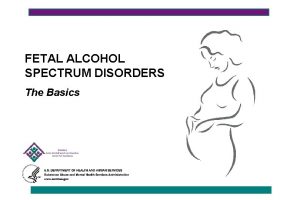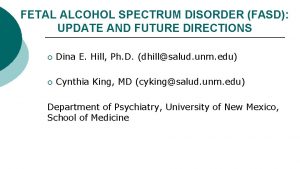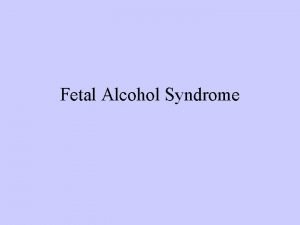Fetal Alcohol Syndrome and Alcohol Related Neurodevelopmental Disorder








































- Slides: 40

Fetal Alcohol Syndrome and Alcohol - Related Neurodevelopmental Disorder William T. Greenough, Ph. D. , and Anna Y. Klintsova, Ph. D. Depts. Psychology, Psychiatry, Cell & Structural Biology and Beckman Institute, University of Illinois, Urbana-Champaign Largely based on the work of Ann Streissguth and colleagues

If you view your role as a physician primarily as one of prescribing and providing medical treatments for illnesses and disorders, you probably won’t be very good at it. Fetal alcohol syndrome and alcohol-related neurodevelopmental disorder illustrate a different aspect of a physician’s role.

Characteristic Facial Features of Child with FAS Short Eyelid Opening, Flat Midface, Short Nose, Indistinct Philtrum (depression beneath the nose), Thin Upper Lip, Epicanthal Folds, Low Nasal Bridge, Minor Ear Abnormalities, Short Chin

Corpus callosum agenesis in FAS patients Control Thin c. callosum Absent c. callosum (From Mattson et al. , 1994)

MR images of 9 -year old girl with FAS C. callosum agenesis Colpocephaly Courtesy of Dr. Sarah Mattson, SDSU

Brain Size Changes in FAS Courtesy of Dr. Sarah Mattson, SDSU

FAS • facial dysmorphology • growth retardation • microcephaly and FAE/ARND • proven maternal alcohol consumption • growth retardation neuropathology • brain damage (behavioral impairment) • behavioral impairment

IQ distribution for FAS and FAE compared with the normal curve (From Streissguth et al. , 1996)

Prevalence of Secondary Disabilities across the Life Span Source: Streissguth et al. Final CDC Report on Secondary Disabilities, 1996

History of Secondary Disabilities by three age groups at interview Source: Streissguth et al. Final CDC Report on Secondary Disabilities, 1996

History of Mental Health Problems (MHP) by sex, diagnosis and age at interview (n=415) Source: Streissguth et al. Final CDC Report on Secondary Disabilities, 1996

History of Mental Health Problems by age at interview (n=415) Source: Streissguth et al. Final CDC Report on Secondary Disabilities, 1996

Learning problems by age at interview (n=395 -407) Source: Streissguth et al. Final CDC Report on Secondary Disabilities, 1996

Repeated behavior problems by age at interview (n=403 -408) Source: Streissguth et al. Final CDC Report on Secondary Disabilities, 1996

History of Confinement: Components of the Secondary Disability by age at interview (n=410 -415) Source: Streissguth et al. Final CDC Report on Secondary Disabilities, 1996

Prevalence of sexual victimization, therapy for ISB, and trouble with the law for sexual behavior by six common inappropriate sexual behaviors: Among females Source: Streissguth et al. Final CDC Report on Secondary Disabilities, 1996

Prevalence of sexual victimization, therapy for ISB, and trouble with the law for sexual behavior by six common inappropriate sexual behaviors: Among males Source: Streissguth et al. Final CDC Report on Secondary Disabilities, 1996

History of Alcohol/Drug Problems (ADP) by sex, diagnosis and age at interview Source: Streissguth et al. Final CDC Report on Secondary Disabilities, 1996

Prevalence of Dependent Living (DPL), by sex and diagnosis Source: Streissguth et al. Final CDC Report on Secondary Disabilities, 1996

History of Problems with Employment (PWE) among clients > 21 years old, by sex and diagnosis (n=90) Source: Streissguth et al. Final CDC Report on Secondary Disabilities, 1996

Five Environmental Protective Factors • Stable and Nurturing Good Quality Home • Infrequent Changes of Household • Not Being a Victim of Violence • Having Received Developmental Disabilities Services • Having Been Diagnosed Before 6 Years of Age --Streissguth, 1997

Educational and public information efforts have not yet effectively reduced the incidence of fetal-alcohol spectrum disorders; to the contrary, risk drinking during pregnancy, including binge drinking, actually increased in the United States between 1991 and 1995 ---Ebrahim, 1999

How Much is Too Much? Outcome of maternal drinking during pregnancy depends on: • stage(s) of fetus development when drinking occurred • peak BAC reached during drinking episode(s) • mother’s individual situation (health and build, nutritional status, level of alcohol dehydrogenase) One drink is too much for a mother at risk

Change in Drinking by pregnant women after contact with Seattle Pregnancy and Health Program (From Little et al. , 1984)

By asking if 1) the individual ever consumes five or more drinks on any occasion, and 2) if she ever feels that she should cut down on drinking, clinicians could detect 92% of the women identified as being at genuine risk by the intervention interview. --Streissguth, 1997

Pregnancy and Health Program Intervention Procedure • Provide Information on Alcohol and Pregnancy • Recommend Abstaining from Alcohol during the remainder of the pregnancy • Help Each Woman Work Out an Individual Plan of Action --Streissguth, 1997

Developing an Action Plan with the Pregnant Patient • “Do you need help with your drinking” • “In what sorts of situations are you likely to drink? ” • “I don’t want you to drink. It matters to me. Your child matters to me. ” • “When is it hardest for you not to drink? ” • NEVER: “One drink a day probably won’t hurt. ” • This is not reinstating “prohibition. ” There are legitimate, scientifically-based reasons not to drink when pregnant.

Developing an Action Plan with the Pregnant Patient Assuming a clear, credible decision is made not to drink: • “The only clear limit for number of drinks per day is none. ” If the patient resists eliminating alcohol consumption entirely: • “How much can you cut down by the next time you see me” • “What can you do to reduce your drinking? ” The goal is to minimize drinking if it cannot be eliminated and to avoid multiple drink situations likely to yield high peak blood alcohol levels. Try to work with pt to restructure behaviors, e. g. . not going out with friends on Friday night after work.

BEHAVIORAL intervention by Physicians offers one of the best hopes for reducing the largest source of mental retardation and developmental delay

What if the patient won’t stop drinking? • Alcohol treatment center referral (e. g. , Prarie Center, New Choice, Mental Health) • If beyond the point of probable serious damage, “There is a set of options. I cannot recommend any particular one, but I can discuss them all with you. Here is where your child may stand. ” (In this context, pregnancy termination is an option. )



Rehabilitation Condition


Inactive Condition





 Fetal alcohol spectrum disorder
Fetal alcohol spectrum disorder Teetotal celebrities
Teetotal celebrities Fetal alcohol syndrome face
Fetal alcohol syndrome face Fetal alcohol syndrome life expectancy
Fetal alcohol syndrome life expectancy Fas facial features
Fas facial features Alcohol
Alcohol Fetal alcohol syndrome life expectancy
Fetal alcohol syndrome life expectancy Fetal alcohol syndrome
Fetal alcohol syndrome Fetal alcohol syndrome
Fetal alcohol syndrome Chapter 11 childhood and neurodevelopmental disorders
Chapter 11 childhood and neurodevelopmental disorders Neurocognitive disorder
Neurocognitive disorder Reflex inhibiting patterns
Reflex inhibiting patterns Neurodevelopmental therapy principles
Neurodevelopmental therapy principles Neurodevelopmental disorders dsm-5 ppt
Neurodevelopmental disorders dsm-5 ppt Neurodevelopmental disorders
Neurodevelopmental disorders Malingering disorder
Malingering disorder Physical fitness is of two types
Physical fitness is of two types Skill related fitness vs health related fitness
Skill related fitness vs health related fitness Fetal valproate syndrome
Fetal valproate syndrome Fetal hydantoin syndrome
Fetal hydantoin syndrome Thalidomide mechanism of action
Thalidomide mechanism of action Fetal phenytoin syndrome
Fetal phenytoin syndrome Teratowa
Teratowa Fetal valproate syndrome
Fetal valproate syndrome Drugs that cross placenta mnemonic
Drugs that cross placenta mnemonic Medical
Medical Turner syndrome is what numerical chromosome disorder?
Turner syndrome is what numerical chromosome disorder? What is secondary alcohol
What is secondary alcohol Primary alcohol secondary alcohol
Primary alcohol secondary alcohol Alcohol flush syndrome
Alcohol flush syndrome Trimester graphic organizer
Trimester graphic organizer Trimester graphic organizer
Trimester graphic organizer Denominator in vertex presentation
Denominator in vertex presentation Chapter 15 maternal and fetal nutrition
Chapter 15 maternal and fetal nutrition Diameters of fetal skull
Diameters of fetal skull Clinical pelvimetry
Clinical pelvimetry Maternal pelvis and fetal skull
Maternal pelvis and fetal skull N
N Maternal pelvis and fetal skull
Maternal pelvis and fetal skull Piggender
Piggender Bpd comorbidity
Bpd comorbidity

